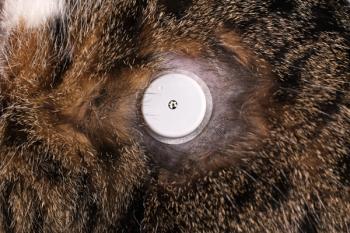
What's new with hypoadrenocorticism in dogs (Proceedings)
Hypoadrenocorticism is an uncommon endocrinopathy, which may be difficult to recognize due to its varied clinical presentation.
What we know
Hypoadrenocorticism is an uncommon endocrinopathy, which may be difficult to recognize due to its varied clinical presentation. It is most frequently seen in young to middle-aged female dogs. A number of breeds have a predisposition to develop this disease, including poodles, great Danes, bearded collies, Nova Scotia duck tolling retrievers, west highland white terriers, and basset hounds. Dogs with hypoadrenocorticism present different ways with chronic non-specific illness or in a severe adrenocortical crisis.
Primary hypoadrenocorticism (Addison's disease) is caused by destruction of the adrenal cortex. It is thought to be an immune-mediated process resulting in inadequate glucocorticoid and mineralocorticoid secretion. In dogs with atypical primary hypoadrenocorticism, serum electrolytes are normal but occasionally have hypoglycemia as their only abnormality. Primary hypoadrenocorticism can be iatrogenic (caused by over treatment of hyperadrenocorticism) and permanent. Secondary hypoadrenocorticism results from deficient pituitary ACTH secretion causing inadequate glucocorticoid production. Abrupt withdrawal of long-term and or high-dose glucocorticoids can cause secondary hypoadrenocorticism, as well as, idiopathic ACTH deficiency, tumors of the pituitary gland or hypothalamus.
The zona fasciculate and zona reticularis divide the inner region of the adrenal gland and are responsible for the production of glucocorticoids. The most common clinical signs of glucocorticoid deficiency are anorexia, lethargy, vomiting, diarrhea, weakness, and weight loss. Less common signs are intermittent and can be associated with stressful events such as grooming, boarding or showing. Physical examinations are usually nonspecific. Clinicopathological abnormalities include normocytic, normochromic, non-regenerative anemia, lack of a stress leukogram, hypoalbuminemia, Hypocholesterolemia, hypoglycemia and hyponatremia. Remember to perform a fecal examination in all cases suspected of hypothyroidism because gastrointestinal parasites can cause the same clinical signs and electrolyte disturbances.
The outer zone of the adrenal gland is the zona glomerulosa, which is responsible for the production and secretion of the mineralocorticoid aldosterone. Mineralocorticoids are released in response to hypovolemia triggering the renin-angiotensin system and hyperkalemia directly increasing aldosterone synthesis. The most common signs of mineralocorticoid deficiency are weakness, polyuria/polydipsia, lethargy and or collapse. These are varied and result from hypovolemia, hypotension, hyponatremia and hyperkalemia. A sodium: potassium (NA: K) ratio of 27 is consistent with mineralocorticoid deficiency, although many diseases can alter this ratio.
Dogs with concurrent glucocorticoid and mineralocorticoid deficiency can have a combination of any of the previously mentioned clinical signs. Radiographs may reveal hypovolemia, microcardia, hypoperfused lung fields and microhepatica. Ultrasound examination usually reveals bilateral atrophy of the adrenal glands. ECG evaluations may document hyperkalemia-related rhythms such as atrial standstill, etc.
Although other methods have been proposed for diagnosing of hypoadrenocorticism, the gold standard is the ACTH stimulation test. The absence of an appropriate response is definitively diagnostic for hypoadrenocorticism. The diagnosis of atypical hypoadrenocorticism is also established by documenting subnormal cortisol response to ACTH.
The treatment for an acute crisis is restoring intravascular volume, alleviating hyperkalemia and hyponatremia, replacing glucocorticoids, treatment of hyperkalemic cardiac rhythms and correction of the metabolic acidosis. Volume is more important than type of fluid however 0.9%NaCl is the fluid of choice. This usually alleviates the severe electrolyte cardiac disturbances rapidly. If it does not cardioprotective calcium gluconate should be administered. Glucocorticoids should be administered after an ACTH stimulation test is performed however administration of dexamethasone is rapid and will not interfere with the cortisol assay whereas other glucocorticoids will. Hydrocortisone is the ideal replacement glucocorticoid because it has glucocorticoid and mineralocorticoid activity. High-dose glucocorticoids are not recommended as they may cause or exacerbate gastrointestinal hemorrhage. Oral supplementation can be given as tolerated. Initial aggressive therapy followed by continued monitoring and supportive care is paramount for a favorable outcome.
Long-term management of hypoadrenocorticism is accomplished by replacing the insufficient hormones. There are two options for mineralocorticoid therapy, fludrocortisone and desoxycorticosterone pivalate (DOCP). Fludrocortisone is the most common mineralocorticoid replacement and given orally, twice daily. Serum electrolytes should be monitored every one to two weeks and dose adjustments made accordingly. After stabilization dogs should be evaluated every three to four months. With time and increasing age, many dogs need an increase in the dosage. Some dogs (50%) require supplemental glucocorticoid treatment in addition. DOCP, a repositol form of mineralocorticoid that has a long duration of action and is slowly released over three to four weeks. Serum electrolytes and BUN should be monitored at 14 and 25 days for the first two to three months until the correct dose and frequency are determined. Electrolyte abnormalities trigger dose changes (increase with hyperkalemia/hyponatremia and decrease with hypokalemia/hypernatremia). On average DOCP is administered every 25 days. The owners can administer at home. This is generally less expensive than fludrocortisone. Maintenance glucocorticoid administration is needed indefinitely with increases surrounding stressful situations as DOCP has negligible glucocorticoid activity. With appropriate therapy and owner compliance, the prognosis is favorable.
What's new?
In the last few years' new studies have provided new information affecting the diagnosis and management of canine hypothyroidism. The rest of this lecture discusses the clinical implications of the recent studies and includes direct citations from the references articles.
• Foley C, Bracker K, Drellich S. Hypothalamic-pituitary axis deficiency following traumatic brain injury in a dog. J Vet Emerg Crit Care 2009; 19(3): 269-274.
- A twelve-week old dog was presented with traumatic brain injury and did not respond to traditional supportive care. Continued hypothermia, electrolyte derangements, hypotension, and hyposthenuria prompted screening for and detection of several hypothalamic-pituitary disorders such as hypoadrenocorticism, central diabetes insipidus, hypothyroidism, and growth hormone deficiency. Electrolyte abnormalities, urine osmolarity and blood pressure improved with treatment for the associated disorders. This is the first report of generalized hypothalamic-pituitary dysfunction following traumatic brain injury in a dog.
• Ramsey IK, Richardson J, et al. Persistent isolated hypocortisolism following brief treatment with trilostane. Aust Vet J 2008; 86(12): 491-495.
- A 12-year-old, male-castrate, Miniature poodle with confirmed pituitary-dependent hyperadrenocorticism was treated with trilostane. After three doses it developed clinical and laboratory changes suggestive of atypical hypoadrenocorticism. It persisted for three months despite drug withdrawal. At that point prednisolone therapy was initiated and required for more than one year. Initial ultrasounds findings demonstrated large hyperechoic adrenal cortices, typical of dogs with hyperadrenocorticism, which then became small and heteroechoic, consistent with the development of adrenal necrosis. This outcome was remarkable for the short duration of trilostane therapy that elicited this complication.
• Lathan P, Moore GE, et al. Use of a low-dose ACTH stimulation test for diagnosis of hypoadrenocorticism in dogs. J Vet Intern Med 2008; 22(4): 1070-1070.
- Definitive diagnosis of hypoadrenocorticism is usually made by adrenocorticotrophic hormone (ACTH) stimulation test using 250 microg/dog of synthetic ACTH (cosyntropin/tetracosactrin); increased costs have prompted veterinarians to find less-expensive methods. Their hypothesis was two-fold 1) low-dose (5 microg/kg) ACTH stimulation test will distinguish between dogs with hypoadrenocorticism and non-adrenal illness and 2) this low-dose administration will not interfere with results of an ACTH stimulation test the following day. The eight healthy dogs each received four ACTH tests. The dogs received either 250 micrograms or 5 microg/kg on day one and the following day got the alternative dose. The opposite sequence was used two weeks later. The 29 suspect hypoadrenocorticism dogs received two ACTH stimulation tests 24 hours apart; either using a dose of 5 microg/kg or 250 micrograms. The results showed that healthy dogs post stimulation cortisol levels were equivalent. In the suspect dogs the two doses were statistically equivalent therefore low-dose ACTH stimulation testing distinguishes between dogs with non-adrenal illness and hypoadrenocorticism. And the administration of two ACTH stimulation tests on consecutive days does not affect the results of the second test.
• Nielsen L, Bell R, et al. Low ratios of sodium to potassium in the serum of 238 dogs. Vet Rec 2008 162(14): 431-435
- Serum sodium: potassium (Na: K) ratios are often reported in serum biochemical profiles of dogs however their value has not been assessed. This study aimed to identify diseases associated with a low Na: K ratio in dogs and to compare their prevalence in dogs with normal Na: K ratios. Twenty-seven dogs were identified from 238 dogs retrospectively. The dogs were grouped into five categories depending on the organ system affected. There were more in the endocrine category than any other group. Hypoadrenocorticism was the most single common cause of low Na: K ratios and affected 16% of the cases. Other problems identified were urogenital cardiorespiratory and gastrointestinal disease.
• Adler JA, Drobatz KJ, Hess RS. Abnormalities of serum electrolyte concentrations in dogs with hypoadrenocorticism. J Vet Intern Med 2007; 21(6): 1168-1173.
- The sensitivity and specificity of the sodium to potassium ratio (NA: K) as a diagnostic aid in canine hypoadrenocorticism is unknown. Their retrospective study purpose was to define the sensitivity and specificity of the NA: K as a diagnostic aid in hypoadrenocorticism. Dog were included in the study if results of an ACTH stimulation test confirmed the diagnosis of hypoadrenocorticism, the serum sodium concentration was below the reference range or the serum potassium concentration was above their reference range and the dog was treated with Mineralocorticoids. Their study documented that the used of NA: K above 27 or 28 identified 95% of dogs correctly as affected or not affected. Therefore dogs with a NA: K of 27 identifies the highest percentage of dogs with mineralocorticoid and glucocorticoid deficiency correctly. In NA: K less than 24 it is best to perform an ACTH stimulation test.
• Lennon EM, Boyle TE, et al. Use of basal serum or plasma cortisol concentrations to rule out a diagnosis of hypoadrenocorticism in dogs: 123 cases (2000-2005). J Am Vet Med Assoc 2007; 231(3): 413-416.
- This retrospective case-control study was to determine whether basal serum or plasma cortisol concentrations could be used as a screening test to rule out hypoadrenocorticism in dogs. It incorporated 110 dogs with non-adrenal illness and 13 dogs with hypoadrenocorticism. The ACTH stimulation test was used to confirm. On the basis of sensitivity and specificity, basal serum or plasma cortisol concentrations had high negative predictive values and could be used to rule out a diagnosis of hypoadrenocorticism. Dogs with basal cortisol concentrations greater than two microg/dL that are not receiving corticosteroids, mitotane or ketoconazole are highly unlikely to have hypoadrenocorticism. However, dogs with basal cortisol concentrations less that 2 microg/dL give little information regarding adrenal glands functions and an ACTH stimulation test should be performed.
• Thompson AL, Scott-Moncrieff JC, Anderson JD. Comparison of classic hypoadrenocorticism with glucocorticoid-deficient hypoadrenocorticism in dogs: 46 cases (1985-2005). J Am Vet Med Assoc 2007; 230(8): 1190-1194.
- The purpose of this retrospective study was to compare dog with glucocorticoid-deficient hypoadrenocorticism (GHD) and those with mineralocorticoid and glucocorticoid-deficient hypoadrenocorticism (MGDH) and determine prevalence, historical and clinic-pathologic markers, and outcome of dogs with GDH. Thirty-five dogs with MGDH and 11 dogs with GDH had their records examined. The results revealed that dogs with GHD were older at the time of diagnosis and had a longer duration of clinical signs prior to diagnosis than those with MGDH. Also dogs with GDH were more likely to be anemic, hypoalbuminemic, and hypocholesterolemic that dogs with MGDH. GDH was more common than reported in a referral population of dogs with primary hypoadrenocorticism. Definitive diagnosis remains a challenge. Absence of a stress leukogram in dogs with signs of illness (especially relating to the gastrointestinal tract) warrants further investigation. Most dogs with primary cortisol deficiency dog not develop mineralocorticoid deficiency.
• Reusch CE, Sieber-Ruckstuh lN, et al. Histological evaluation of the adrenal glands of seven dogs with hyperadrenocorticism treated with trilostane. Vet Rec 2007; 160(7): 219-224.
- The adrenal glands of seven hyperadrenocorticoid dogs treated with trilostane were histologically studied. Six dogs with pituitary-dependent hyperadrenocorticism (PDH) had moderate to severe (diffuse or nodular) cortical hyperplasia. The zona glomerulosa was normal and the lesions in the zona fasciculate were more severe than the zona reticularis. In the dog with a functional adrenal tumor the non-tumor bearing adrenal gland had mild nodular hyperplasia. Five of seven dogs had variable degrees of adrenal necrosis, which was severe in two of them. Areas of cell death as apoptosis were noted in three. There were variable degrees of cortical hemorrhage in three dogs, some severe enough to lead to hypoadrenocorticism.
References available on request
Newsletter
From exam room tips to practice management insights, get trusted veterinary news delivered straight to your inbox—subscribe to dvm360.




